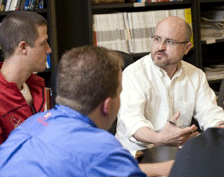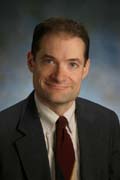
THE IMAGE OF THE GAY JOURNALIST
IN POPULAR CULTURE
Updated 7-2010
Dedication
"The Image of the Gay Journalist in Popular Culture" project is dedicated to the memory of a great journalist, colleague and friend, Leroy F. Aarons, one of the earliest supporters of the IJPC. When no one cared about the IJPC, Roy was there to offer advice and inspiration. In 2000, he told me: "Someday when academics and journalists see how indispensable the IJPC is to their work and profession, you'll be happy you didn't give up when no one cared much about what you were doing. I've been there. And I know what I'm talking about. So sign me up as an IJPC Associate because I want to be in on the ground floor." We miss Roy very much.
– Joe Saltzman, IJPC Director, 2009
There has been virtually no research done on the image of the gay journalist in popular culture. We want to explore the image of the gay journalist and public relations practitioner in movies, television, novels, comic books and other areas of popular culture. Below are resources for research and class use.
THE IMAGE OF THE GAY JOURNALIST IN POPULAR CULTURE – A BIBLIOGRAPHY. This bibliography is being constantly updated. Please contribute any missing pieces by e-mailing .(JavaScript must be enabled to view this email address) with additions and corrections. Update: 7-2009
THE IMAGE OF THE GAY JOURNALIST IN MOVIES AND TV 1929 to 2009 a three-disc, 4:42:23 video compilation with 123 movie and television clips tracing the history of the gay journalist in the 20th and 21st centuries. Also included is a special supplement on The Image of the Gay Public Relations Practitioner in Movies and Television.This video compilation now available by joining the IJPC Associates. Click here for a special Annenberg Research Seminar video on IJPC research into the image of the gay journalist in movies and TV.
Beauty, Brains and Bylines: Comparing the Female Journalist in the fiction of Sherryl Woods and Sarah Shankman by Amanda Marie Rossie. This work examines the image of the female journalist in two series of novels by authors Sherryl Woods and Sarah Shankman. Tracing the image of the female journalist from its historical roots to its appearance in late twentieth-century fiction, this study uses the two main protagonists as a guide. Focusing on major stereotypes like the sob sister, stunt reporter, victim, and “one of the boys,” this work contextualizes her image alongside her real-life popular culture counterparts. Close examinations of the characters’ relationships with men, newsgathering ethics, and publicity they experience as successful female reporters working in a predominately male profession are crucial to the larger picture to which these images contribute. The authors’ attempts at reproducing accurate representations of females within the newsroom and portraying progressive, liberated representations of womanhood are also considered. The final chapter analyzes the series’ raceless Southern settings as both a historical impossibility and the creation of a utopian society that propagates racism without “racists.”
THE GAY DETECTIVE NOVEL: LESBIAN AND GAY MAIN CHARACTERS & THEMES IN MYSTERY FICTION by Judith A. Markowitz with a foreword by Katherine V. Forrest, 302 pages. McFarland & Co. October, 2004, "Journalism," 112 to 121, 126-151. This is an excellent introduction to the image of the gay journalist in mysteries.
SCREENED OUT: PLAYING GAY IN HOLLYWOOD FROM EDISON TO STONEWALL by Richard Barrios, 476 pages, Routledge, 2002. Good source for hard-to-find gay journalists in film.
The National Communication Association 95th Annual Convention, November 12-15, 2009 in Chicago features a panel, "The Image of the Gay Journalist in Popular Culture," sponsored by The Gay, Lesbian, Bisexual and Transgender group at 2 to 3;15 p.m., Thursday, November 12 in conjunction with one of the convention's themes "Being Gay, Lesbian, Bisexual, Transgendered, or Queer in Today's Society." Moderator and Discussant will be Joe Saltzman, Professor of Journalism and Director of the Image of the Journalist in Popular Culture (IJPC), Annenberg School for Communication at the University of Southern California. panelists include Gary Hicks, Associate Professor, Southern Illinois University-Edwardsville, Matthew Ehrlich, Professor, University of Illinois, and Sammye Johnson, Professor, Trinity University. For a report on the image of the gay journalist in movies and television, 1929-2009, click here for an Annenberg Research Seminar presentation by Joe Saltzman.
 THE ASSOCIATION FOR EDUCATION FOR JOURNALISM AND MASS COMMUNICATION (AEJMC) in Boston features a PF&R Panel "The Image of the Gay Journalist in Popular Culture" sponsored by the Entertainment Studies Interest Group and The Gay, Lesbian, Bisexual and Transgender Interest Group at 10 to 11:30 a.m., Wednesday, August 5, 2009.
THE ASSOCIATION FOR EDUCATION FOR JOURNALISM AND MASS COMMUNICATION (AEJMC) in Boston features a PF&R Panel "The Image of the Gay Journalist in Popular Culture" sponsored by the Entertainment Studies Interest Group and The Gay, Lesbian, Bisexual and Transgender Interest Group at 10 to 11:30 a.m., Wednesday, August 5, 2009.
Moderator and Discussant: Joe Saltzman, Professor of Journalism and Director of the Image of the Journalist in Popular Culture (IJPC), Annenberg School for Communication, University of Southern California previewed an excerpt from the three-disc, 4:42:23 "The Image of the Gay Journalist in Movies and Television, 1929-2009." He will also presented recent IJPC research on the subject.
 Panelists include Gary Hicks, Associate Professor, Southern Illinois University-Edwardsville who will speak on If We Could Just Learn Not to Hate Ourselves Quite So Very Much: Gay Journalists and The Self-Perpetuating Stigma": "From his first furtive appearance in film, the gay-identified journalist has lived between two worlds, balancing between the expectations of the rough and rowdy world of journalism as depicted in motion pictures, and his own mostly hidden private life. Whether openly gay, or, as was most often the case, identifiable only through vague reference, the character of the gay journalist has oftentimes been his own worst enemy. This presentation focuses on films that allude to a character's homosexuality and then use it against him -- usually with his own acquiescence. This internalized homophobia usually works again the film's character, and arguably against the public's perception of gay people."
Panelists include Gary Hicks, Associate Professor, Southern Illinois University-Edwardsville who will speak on If We Could Just Learn Not to Hate Ourselves Quite So Very Much: Gay Journalists and The Self-Perpetuating Stigma": "From his first furtive appearance in film, the gay-identified journalist has lived between two worlds, balancing between the expectations of the rough and rowdy world of journalism as depicted in motion pictures, and his own mostly hidden private life. Whether openly gay, or, as was most often the case, identifiable only through vague reference, the character of the gay journalist has oftentimes been his own worst enemy. This presentation focuses on films that allude to a character's homosexuality and then use it against him -- usually with his own acquiescence. This internalized homophobia usually works again the film's character, and arguably against the public's perception of gay people."
 Matthew Ehrlich, Professor, University of Illinois who will talk about The Twenty-First Century Gay Movie Journalist: ‘The Devil Wears Prada'": “`The Devil Wears Prada' poignantly illustrates the mixed portrayal of the gay journalist in contemporary Hollywood cinema. On the one hand, the fashion editor character Nigel is a progressive depiction. He is intelligent and successful, and he does not exist solely to provide comic relief via broad stereotypes of how gay people supposedly behave. On the other hand, Nigel is only a supporting character whose main function is to serve as a consultant and confidante for the female protagonists. He has no apparent relationships with men (romantic or otherwise), and he is not seen doing much journalism (fashion or otherwise). Nigel’s character raises the question of how far successful mainstream movies can or will go in honestly portraying the gay journalist."
Matthew Ehrlich, Professor, University of Illinois who will talk about The Twenty-First Century Gay Movie Journalist: ‘The Devil Wears Prada'": “`The Devil Wears Prada' poignantly illustrates the mixed portrayal of the gay journalist in contemporary Hollywood cinema. On the one hand, the fashion editor character Nigel is a progressive depiction. He is intelligent and successful, and he does not exist solely to provide comic relief via broad stereotypes of how gay people supposedly behave. On the other hand, Nigel is only a supporting character whose main function is to serve as a consultant and confidante for the female protagonists. He has no apparent relationships with men (romantic or otherwise), and he is not seen doing much journalism (fashion or otherwise). Nigel’s character raises the question of how far successful mainstream movies can or will go in honestly portraying the gay journalist."
 Sammye Johnson, Professor, Trinity University whose topic is, The Lesbian Journalist as Sleuth: The Nyla Wade Mysteries: “The detective story/mystery is one of the most popular genres in book publishing, with protagonists ranging from tough Philip Marlowe to gentle Miss Marple, and from cerebral Hercule Poirot to pragmatic Kinsey Millhone. While there have been several journalist-as-sleuth novels (the Britt Montero series and most recently, Jack McEvoy), feminist writer Vicki P. McConnell offers one of the few mystery series with a lesbian journalist as sleuth. This paper looks at the three Nyla Wade novels by McConnell as focusing both on the professional development of a female investigative reporter in the early 1980s and on her journey to self-awareness and realization as a lesbian.
Sammye Johnson, Professor, Trinity University whose topic is, The Lesbian Journalist as Sleuth: The Nyla Wade Mysteries: “The detective story/mystery is one of the most popular genres in book publishing, with protagonists ranging from tough Philip Marlowe to gentle Miss Marple, and from cerebral Hercule Poirot to pragmatic Kinsey Millhone. While there have been several journalist-as-sleuth novels (the Britt Montero series and most recently, Jack McEvoy), feminist writer Vicki P. McConnell offers one of the few mystery series with a lesbian journalist as sleuth. This paper looks at the three Nyla Wade novels by McConnell as focusing both on the professional development of a female investigative reporter in the early 1980s and on her journey to self-awareness and realization as a lesbian.